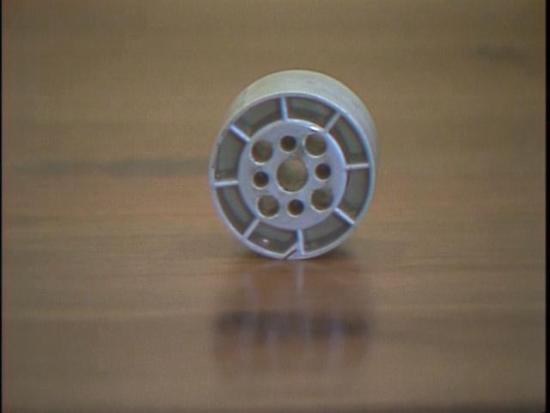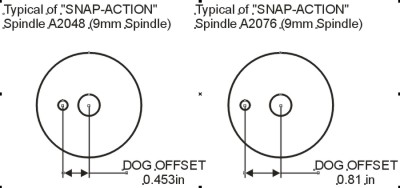|
|
 
|
|
Author
|
Topic: what is this core?
|
|
|
|
|
Stephen Furley
Film God

Posts: 3059
From: Coulsdon, Croydon, England
Registered: May 2002
|
 posted 07-13-2008 04:44 PM
posted 07-13-2008 04:44 PM




Steve,
You mentioned these cores with a 9mm bore once before, but I've never actually seen one.
This would explain the hand rewind at the Clocktower when I was projecting there. We tend to use a plate on a rewind bench, rather than a split spool. this rewind had fixed plates on both sides, and used to have square spindles for 16mm. When they stopped running 16mm these spindles were replaced by 9mm ones for 35mm spools. when using spools the flange of the spool rests on the fixed plate, and when using standard cores with a 1" bore the standard plate fits on the spindle, so there are two plates on that side. I haven't seen one like it, but it would allow the use of a core like this, without needing the normal separate plate as well.
I have seen cores with a small 5/16" or 3/8" hole, but these have been very old wooden ones.
Scott, is that core metal?
| IP: Logged
|
|
|
|
|
|
|
|
|
|
|
|
Stephen Furley
Film God

Posts: 3059
From: Coulsdon, Croydon, England
Registered: May 2002
|
 posted 07-15-2008 01:49 AM
posted 07-15-2008 01:49 AM




The closer spaced one above looks like the ones we have here, though I don't have one at home at the moment that I can measure.
Old Kalee 3/8" spools will fit on Kinoton 9mm Spindles, though there is a problem using them for take-up,
I've seen several different versions of 1/2". Towers generally have one dog pin, though premier rewinders have two, spaced at 180 degrees. Cinemeccanica plastic spools have four holes spaced at 90 degrees, but some tower spools have three holes, spaced at 120 degrees, and so will not fit on a spindle with two dogs, such as the Premier rewinder has. Again, I don't have one handy to measure, but I think the dog on all of the 1/2" spindles I've seen has been smaller than 8mm.
Kinoton list both European and American 1/2" spindles for their machines, but I never knew what the difference was.
The old GBN portable that I've seen at Bletchley Park has 1/2" spindles, but with a smaller dog, in about the same position as the 9mm one.
I've seen several different versions of 5/16" spindles; the one with a key, as is common in the US, but much less so here now, though it was more widely used in the past. There's another version with a dog, like a smaller version of the 9mm one, and one with a square, as is used for 16mm film. I've only seen this used for microfilm, and it's convenient where both 16mm and 35mm film are used on the same reader. Was 5/16" ever used for 70mm, or any of the other wide gauges? I have seen it used with 6k spools of 35mm, at the ICA Cinema 1 in London for example, but I don't like it with that much weight on it.
The large spools used on the Fedi Solo fit a much larger spindle, about 20-25mm, and the Mk.1 BTH SUPA had a weird arrangement, a sort of large, splined, thing from memory, though it's some years since I've seen one.
Of course, very early projectors generally didn't use spools at all, and when they did start to be used there were no standards, and so each model was different.
So, that's three different 5/16" ones, two different 9mm, one 3/8", four different 1/2", plus a few odd ones. Anybody know of any others?
Dogs seem to have been more of a European thing, Pathe used smaller versions of them for both 9.5mm and 17.5mm, but Kodak didn't on 16mm, 8mm and Super-8. I think the Pathe 28mm used a key, but It's a long time since I've seen one of those.
What do you do over there when you have projectors which take 1/2" spools, all of the 'shipping reels' seem to be 5/16", do you have a rewinder with different spindles on each end, or interchangeable spindles, or adapters, or what? Apart from the flat 'table' type most rewinders here either have fixed spindles, or ones which can be changed, but it's a screwdriver or allen key job, not very convenient if you're changing size frequently. To wind on or off a core we just slip the plate onto the spindle on one side or the other.
I know of a couple of places with more than one screen, which use different sizes in each; they tend to use the Cinemeccanica plastic spools, with interchangeable centres, to move prints from one to the other.
It looks like I may be 'un-retired' to project again for just one day soon, 9mm on Kinotons, which suits me just fine.
[ 07-15-2008, 10:12 AM: Message edited by: Stephen Furley ]
| IP: Logged
|
|
|
|
|
|
John Walsh
Film God

Posts: 2490
From: Connecticut, USA, Earth, Milky Way
Registered: Oct 1999
|
 posted 07-15-2008 10:13 AM
posted 07-15-2008 10:13 AM




I have seen 70mm trailer flanges with smaller (5/16") spindle holes, but they only held about 10 min of film; mostly for editing tables.
6000ft 35mm reels with 5/16" spindles are fairly common here in the US; I think they came into being during the later 1950's or so when longer running times were desired, (either for 3D or just for operator convenience.) Projector manufacturers probably (at first) just started making their existing magazines larger, but with the same spindle parts. Also, the rewind tables then in use didn't have changeable spindles. So, snce you needed to buy a larger reel anyway, get one with a spindle that matches what you already have .. I guess. Although, Stephen is right; the extra weight really wrecks the spindle.
OT - Wasn't there a record album where you actually had to drill your own hole?
| IP: Logged
|
|
|
|
|
|
|
|
All times are Central (GMT -6:00)
|
|
Powered by Infopop Corporation
UBB.classicTM
6.3.1.2
The Film-Tech Forums are designed for various members related to the cinema industry to express their opinions, viewpoints and testimonials on various products, services and events based upon speculation, personal knowledge and factual information through use, therefore all views represented here allow no liability upon the publishers of this web site and the owners of said views assume no liability for any ill will resulting from these postings. The posts made here are for educational as well as entertainment purposes and as such anyone viewing this portion of the website must accept these views as statements of the author of that opinion
and agrees to release the authors from any and all liability.
|

 Home
Home
 Products
Products
 Store
Store
 Forum
Forum
 Warehouse
Warehouse
 Contact Us
Contact Us




 Printer-friendly view of this topic
Printer-friendly view of this topic












![[Cool]](cool.gif)

![[Big Grin]](biggrin.gif)



